Anatomy and Physiology of White Blood Cells (Leukocytes)
1/30
There's no tags or description
Looks like no tags are added yet.
Name | Mastery | Learn | Test | Matching | Spaced |
|---|
No study sessions yet.
31 Terms
What are the main characteristics of leukocytes?
5 types of WBC
Have a nucleus and are colorless in fresh blood
They comprise the cellular components of the immune system
They migrate through capillary walls into body tissues
What stains do we use when looking at blood stains?
Romanovsky Type Stains
Mixture of basic dye (methylene blue) and an acidic dye (eosin)
Used specifically for staining blood smears
What are the basis of creating subdivisions of WBCs?
Nuclear appearance
Specific staining affinity of cytoplasmic granules with romanovsky type stains
Is there regular or irregular cytoplasm, is there a lot, a little, are there granules?
What categories are the WBCs divided into?
1.) Granulocytes
(polymorphs/polymorphonculear) - irregular nucleus
Neutrophils
Eosinophils
Basophiles
2.) Agranulocytes
(Mononuclear) - round/slightly indented nuclei
Lack granulocytes
Lymphocytes
Monocytes
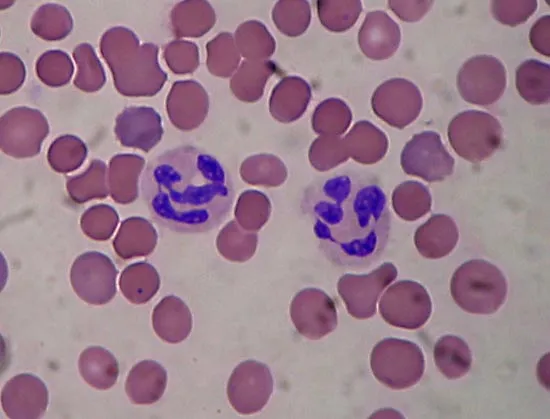
What type of WBC is this?
Neutrophil
What do we need to know about the proportions of WBC in an animal?
WBC look different in different species, but proportions in a blood sample also vary depending on the species you are looking at.
% of each type of WBC varies depending on species
In all species, Basophils are present in the smallest number
The largest numbers are typically monocytes and lymphocytes
What is hematopoeisis?
process describing the formation of the formed elements (everything other than plasma) of blood occur in the blood marrow
All begins with multipotent stem cells
Early subdivision into two two lineages (Myeloid and Lymphoid)
What is granulopoeisis?
Process giving rise to granulocytic series of WBCs in the bone marrow
We should not see immature forms of the WBCs in the blood, if we see band neutrophils, it may indicate infection
What are the main features of neutrophils?
Also called Polymorphs
Are granulocytes
Approximately 12um diameter
Quite large, an RBC - usually 5um
Characteristic segmented nucleus with 3-5 lobes, more as the cell matures
2 types of granules (specific and non-specific)
Specific staining granules too small to be seen in the dog
Some species variation
Commonest type of WBC in dog blood (But not true in all species)
What is the lifespan like in a neutrophil?
What is their distribution like in the body/circulation?
What are their main functions?
If they cannot perform their main functions what happens?
Maturation process in BM = 6 days, to be released with 3 lobes into circulation
Bone marrow - circulating neutrophil pool
Marginating neutrophil pool - passively delay transit time (spleen and lung)
Only the cells in the circulating pool are picked up during blood sampling (As opposed to the marginating neutrophil pool)
If they are not required, they will pass out of the vascular system, enter tissues to perform function OR
In 7-14 hours they will be lost from body surfaces or destroyed by macrophages
Functionally:
First responders to infection, the innate inflammatory response
Occurs in the connective tissue space
No re-entry into the circulation after migration into tissue, they can last here for 1-4 days
How do white blood cells exit the vascular system?
Extravasation, leukocyte adhesion cascade or diapedesis
Neutrophils from vascular system enters the connective tissue by squeezing between endothelial cells lining the blood vessels (post capillary venules)
4 STEPS:
1.) Chemoattraction
2.) Rolling adhesion
3.) Tight adhesion
4.) Transmigration
**ALL WBC enter connective tissue via this route
What are the main functions of neutrophils?
First responders to infection/part of the innate inflammatory response
Cell is an active phagocyte (Goes around like “pacman” and engulfs bacteria, granules help break down substances)
Cell can only do this so many times before dying (puss)
Can modulate inflammatory response (bring in other cells to respond), and tissue damage
What contributes to the formation of pus and fever?
Dead neutrophils form puss
When they burst open, they release pyrogens that cause fever
What is neutrophilia?
Ongoing infection, characterized by release of immature forms (Band neutrophils) from the bone marrow
What are the main features of eosinophils?
Granulocyte
2-8% of total WBC
Typically a bi-lobed nucleus
Characteristic features are - eosinophilic “pink” staining cytoplasmic granules
Species differences
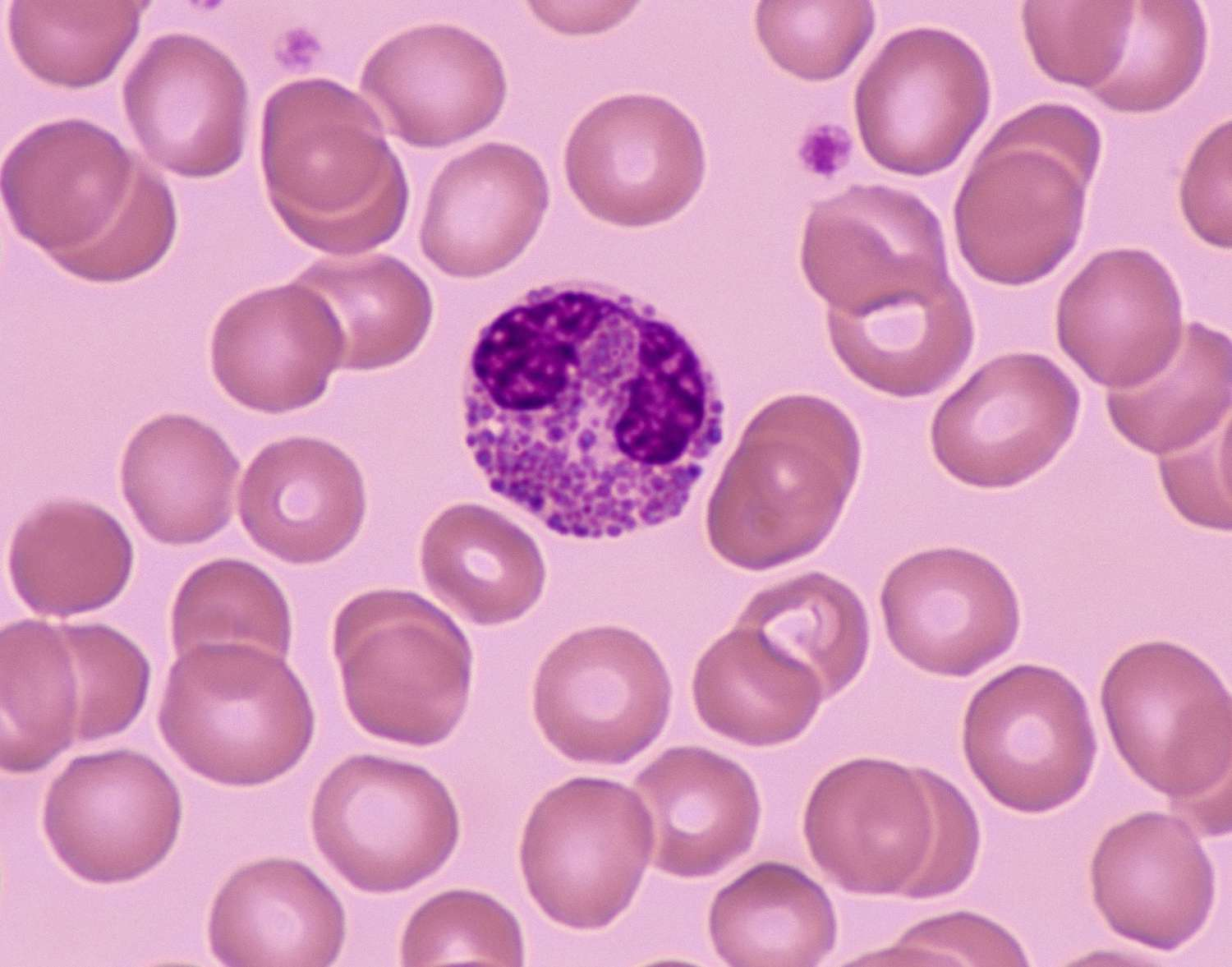
What type of WBC is this?
Eosinophil
What are the lifespan of eosinophils?
What is their main function?
Take 2-6 days to develop in BM, spending 1-24 hrs in circulation
Exit to the tissue (skin, GI, lungs) that is often exposed to the environment, lasts for 2 days to 2 weeks
Functions:
Active participants in many immune responses (e.g. phagocytosis of Ag/Ab complexes)
Regulate Inflammation
Histamine and enhance the release of histamine and serotonin from other cells of the immune system
Beneficial role in host defense against nematode and other parasitic infections
e.g. they degranulate ont the surface of helminths
**But can also be damaging as part of the inflammatory process of allergic diseases, e.g. eosinophils and asthma
What are the main features of basophils?
Granulocyte
Rare (0-0.5% of total WBC)
Bi-lobed or multi-lobed nucleus
Main characteristics: purple (Basophilic-blue), specific staining cytoplasmic granules
Species variation in number and staining
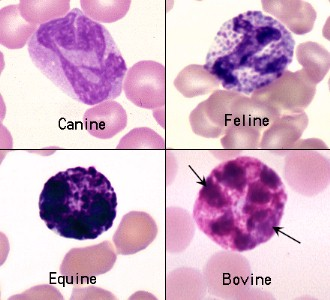
What WBC is this?
Basophil
What are the main functions of basophils?
Role in inflammatory and allergic type reactions
Non-specific and limited phagocytic activity
De-granulate on contact with antigens, separate foreign pathogens out so immune system can better deal with them
Granules contain…
Vasodilantion
Anticoagulant
Supplement the action of mast cells (Sit in the connective tissues, when stimulated burst open like basophils, similar roles but are DIFFERENT)
**Play a role in severe allergic reactions - release of leukotriene, which promotes inflammation, causing airway constriction
Lifespan, thought to be a few days
What are the main functions of monocytes?
Agranulocyte
Largest type of WBC: 12-18um
3-8% of total WBC
Variably shaped nucleus
Cytoplasm abundant greyish blue, often foamy or vacuolated
LOTS of cytoplasm, not clear
Develop and stored in bone marrow and spleen
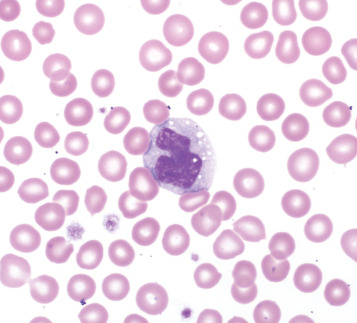
What type of WBC is this?
Monocyte
What is the lifespan and function of a monocyte?
Have a short, transient time in bood, are recruited into the tissue (Connective) where they differentiate into connective tissue macrophages
Variable lifespan
Macrophages are present in the immune system within connective tissue, ready to deal with threats
What are the features of lymphocytes?
Round, densely stained nucleus and scant but intensely stained “skyblue” cytoplasm
Approximate size of RBC
Note that medium and large lymphocytes are found in some species
What are the functions of lymphocytes?
Humoral immunity (B cells) + Cellular Immunity (T cells)
Different populations in blood
T-Cells: mediated immune reactions, leave bone marrow and mature in thymus
B cells: antibody production, lymphopoeisis completed in bone marrow
Circulating B and T lymphocytes cannot be easily distinguished in blood smears

What type of WBC is this?
Lymphocyte
What is the migration system of lymphocytes like?
Migrate and are stored in secondary lymphatic organs and tissues
Have a variable lifespan
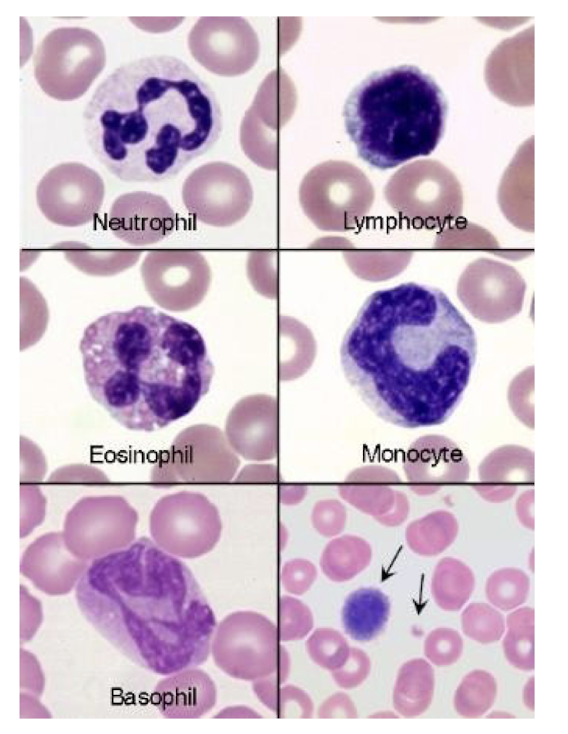
What animal blood is this?
Canine
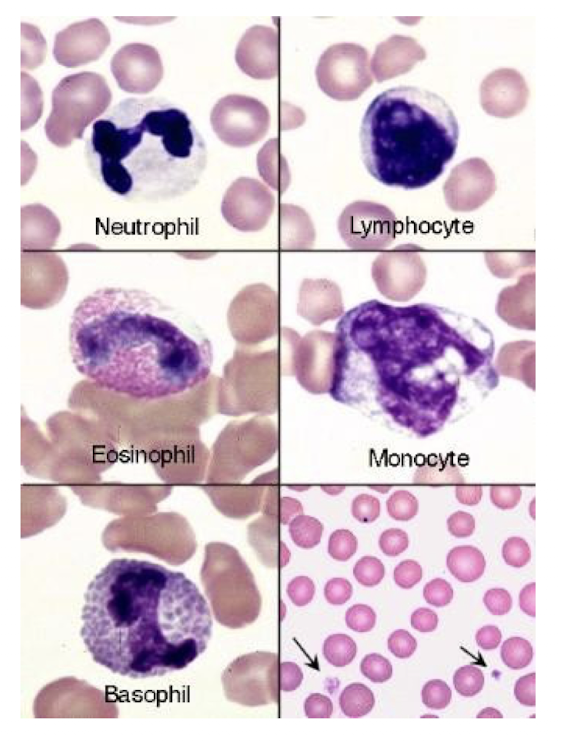
What animal blood is this?
Feline
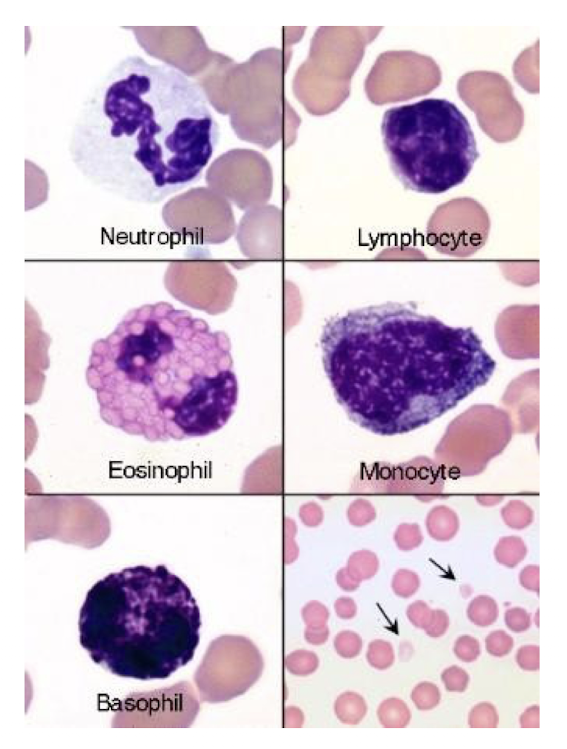
What animal blood is this?
Equine
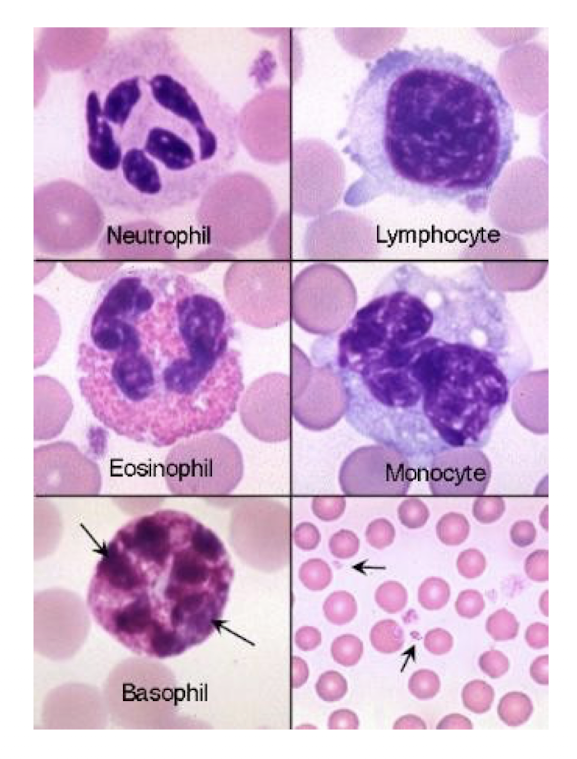
What animal blood is this?
Bovine